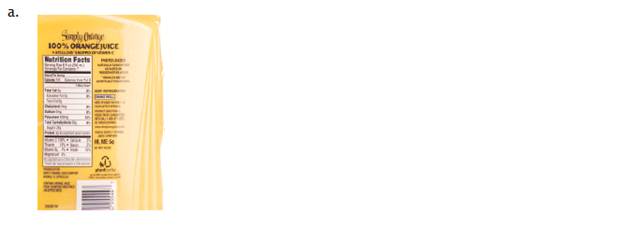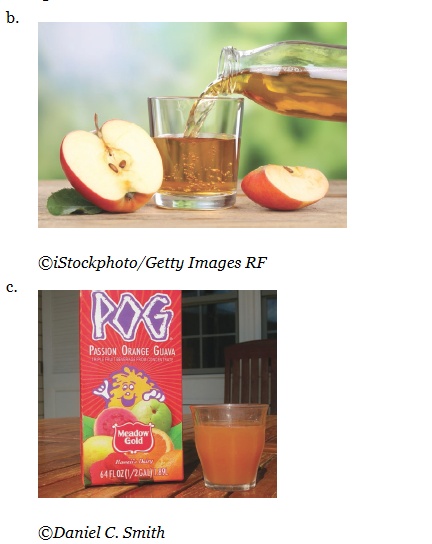
GENERAL,ORGANIC, & BIOLOGICAL CHEM-ACCES
4th Edition
ISBN: 9781265982959
Author: SMITH
Publisher: MCG
expand_more
expand_more
format_list_bulleted
Concept explainers
Textbook Question
Chapter 8.1, Problem 8.2P
Use the appearance of each product to classify it as a solution, colloid, or suspension: (a)orange juice (with the label shown); (b) apple juice; (c) passion orange guava (POG) drink.


Expert Solution & Answer
Trending nowThis is a popular solution!

Students have asked these similar questions
Please see photo
Complete the equation...see image
Complete the equation...see image
Chapter 8 Solutions
GENERAL,ORGANIC, & BIOLOGICAL CHEM-ACCES
Ch. 8.1 - Classify each substance as a heterogeneous...Ch. 8.1 - Use the appearance of each product to classify it...Ch. 8.2 - Consider the following diagrams for an aqueous...Ch. 8.2 - Classify each solution as an electrolyte or...Ch. 8.2 - Using the given number of moles, determine how...Ch. 8.2 - Prob. 8.2PPCh. 8.2 - A solution contains the following ions:...Ch. 8.2 - If a solution contains 125 mEq of Na+ per liter,...Ch. 8.3 - Which compounds are water soluble? a. NaNO3 b. CH4...Ch. 8.3 - Prob. 8.7P
Ch. 8.3 - Use the solubility rules to predict whether the...Ch. 8.3 - Use the solubility rules for ionic compounds to...Ch. 8.4 - Why does a soft drink become "flat" faster when it...Ch. 8.4 - Predict the effect each change has on the...Ch. 8.5 - A commercial mouthwash contains 4.3 g of ethanol...Ch. 8.5 - What is the weight/volume percent concentration of...Ch. 8.5 - Prob. 8.6PPCh. 8.5 - Prob. 8.7PPCh. 8.5 - A drink sold in a health food store contains 0.50%...Ch. 8.5 - Prob. 8.12PCh. 8.5 - What is the concentration in parts per million of...Ch. 8.6 - Prob. 8.10PPCh. 8.6 - Prob. 8.13PCh. 8.6 - Prob. 8.11PPCh. 8.6 - Prob. 8.12PPCh. 8.6 - How many grams of NaCl are contained in each of...Ch. 8.6 - How many milliliters of a 0.25 M sucrose solution...Ch. 8.7 - What is the concentration of a solution formed by...Ch. 8.7 - If the solution of A+B- in X is diluted, which...Ch. 8.7 - Prob. 8.15PPCh. 8.7 - Prob. 8.16PCh. 8.8 - What is the boiling point of a solution prepared...Ch. 8.8 - Representations A, B, and C each show an aqueous...Ch. 8.8 - Prob. 8.18PPCh. 8.8 - What is the melting point of a solution that is...Ch. 8.9 - Which solution in each pair exerts the greater...Ch. 8.9 - Prob. 8.19PCh. 8.9 - Consider the two aqueous solutions separated by a...Ch. 8.9 - What happens to a red blood cell when it is placed...Ch. 8 - Prob. 21PCh. 8 - Prob. 22PCh. 8 - Prob. 23PCh. 8 - Which representation of molecular art better shows...Ch. 8 - Classify each of the following as a solution,...Ch. 8 - Classify each of the following as a solution,...Ch. 8 - Prob. 27PCh. 8 - Label each diagram as a strong electrolyte, weak...Ch. 8 - Prob. 29PCh. 8 - Prob. 30PCh. 8 - Prob. 31PCh. 8 - Prob. 32PCh. 8 - Consider a mixture of two substances shown in blue...Ch. 8 - Which diagram (C or D) best represents what occurs...Ch. 8 - If the solubilityofKClin 100 mL of H2O is 34 g at...Ch. 8 - If the solubilityofsucrosein 100 mL of H2O is 204...Ch. 8 - Prob. 37PCh. 8 - Prob. 38PCh. 8 - Using the ball-and-stick model for methanol...Ch. 8 - Prob. 40PCh. 8 - Prob. 41PCh. 8 - Prob. 42PCh. 8 - Prob. 43PCh. 8 - Prob. 44PCh. 8 - Prob. 45PCh. 8 - Prob. 46PCh. 8 - Prob. 47PCh. 8 - How is the solubility of helium gas in water...Ch. 8 - Use the solubility rules listed in Section 8.3B to...Ch. 8 - Use the solubility rules listed in Section 8.3B to...Ch. 8 - Prob. 51PCh. 8 - Prob. 52PCh. 8 - Prob. 53PCh. 8 - Prob. 54PCh. 8 - Prob. 55PCh. 8 - Prob. 56PCh. 8 - Prob. 57PCh. 8 - Prob. 58PCh. 8 - How would you use a 250-mL volumetric flask to...Ch. 8 - How would you use a 250-mLvolumetric flask to...Ch. 8 - Prob. 61PCh. 8 - Prob. 62PCh. 8 - Prob. 63PCh. 8 - Prob. 64PCh. 8 - Prob. 65PCh. 8 - What is the molarity of a 20.0% (v/v) aqueous...Ch. 8 - Prob. 67PCh. 8 - Prob. 68PCh. 8 - Prob. 69PCh. 8 - Prob. 70PCh. 8 - Prob. 71PCh. 8 - Prob. 72PCh. 8 - Prob. 73PCh. 8 - Prob. 74PCh. 8 - Prob. 75PCh. 8 - Prob. 76PCh. 8 - Prob. 77PCh. 8 - Representations A (containing 1.0 mol ofNaCl) and...Ch. 8 - What is the boiling point of a solution that...Ch. 8 - Prob. 80PCh. 8 - If 150 g of ethylene glycol (C2H6O2) is added to...Ch. 8 - Prob. 82PCh. 8 - Prob. 83PCh. 8 - Prob. 84PCh. 8 - Which solution in each pair has the higher melting...Ch. 8 - Prob. 86PCh. 8 - A flask contains two compartments (A and B) with...Ch. 8 - A flask contains two compartments (A and B) with...Ch. 8 - The molecular art illustrates a red blood cell in...Ch. 8 - Prob. 90PCh. 8 - Prob. 91PCh. 8 - Explain why more sugar dissolves in a cup of hot...Ch. 8 - If the concentration of glucose in the blood is...Ch. 8 - Prob. 94PCh. 8 - Mannitol, a carbohydrate, is supplied as a 25%...Ch. 8 - A patient receives 750 ml, of a 10.% (w/v) aqueous...Ch. 8 - Explain why a cucumber placed in a concentrated...Ch. 8 - Explain why a cucumber placed in a concentrated...Ch. 8 - Prob. 99PCh. 8 - Prob. 100PCh. 8 - Prob. 101PCh. 8 - Prob. 102PCh. 8 - The therapeutic concentration—the concentration...Ch. 8 - Prob. 104CP
Knowledge Booster
Learn more about
Need a deep-dive on the concept behind this application? Look no further. Learn more about this topic, chemistry and related others by exploring similar questions and additional content below.Similar questions
- =Naming benzene derivatives Name these organic compounds: structure C1 CH3 name ☐ CH3 ப C1 × ☐arrow_forwardBlocking Group are use to put 2 large sterically repulsive group ortho. Show the correct sequence toconnect the reagent to product with the highest yield possible. * see image **NOTE: The compound on the left is the starting point, and the compound on the right is the final product. Please show the steps in between to get from start to final, please. These are not two different compounds that need to be worked.arrow_forwardI dont understand this.arrow_forward
- Can you please explain this prooblem to me, show me how the conjugation is added, did I add them in the correct places and if so please show me. Thanks!arrow_forwardBasic strength of organic bases.arrow_forwardNucleophilic Aromatic Substitution: What is the product of the reaction? What is the name of the intermediate complex? *See imagearrow_forward
arrow_back_ios
SEE MORE QUESTIONS
arrow_forward_ios
Recommended textbooks for you
- Chemistry: Matter and ChangeChemistryISBN:9780078746376Author:Dinah Zike, Laurel Dingrando, Nicholas Hainen, Cheryl WistromPublisher:Glencoe/McGraw-Hill School Pub Co
 ChemistryChemistryISBN:9781305957404Author:Steven S. Zumdahl, Susan A. Zumdahl, Donald J. DeCostePublisher:Cengage Learning
ChemistryChemistryISBN:9781305957404Author:Steven S. Zumdahl, Susan A. Zumdahl, Donald J. DeCostePublisher:Cengage Learning Chemistry: An Atoms First ApproachChemistryISBN:9781305079243Author:Steven S. Zumdahl, Susan A. ZumdahlPublisher:Cengage Learning
Chemistry: An Atoms First ApproachChemistryISBN:9781305079243Author:Steven S. Zumdahl, Susan A. ZumdahlPublisher:Cengage Learning 
 General Chemistry - Standalone book (MindTap Cour...ChemistryISBN:9781305580343Author:Steven D. Gammon, Ebbing, Darrell Ebbing, Steven D., Darrell; Gammon, Darrell Ebbing; Steven D. Gammon, Darrell D.; Gammon, Ebbing; Steven D. Gammon; DarrellPublisher:Cengage Learning
General Chemistry - Standalone book (MindTap Cour...ChemistryISBN:9781305580343Author:Steven D. Gammon, Ebbing, Darrell Ebbing, Steven D., Darrell; Gammon, Darrell Ebbing; Steven D. Gammon, Darrell D.; Gammon, Ebbing; Steven D. Gammon; DarrellPublisher:Cengage Learning Chemistry by OpenStax (2015-05-04)ChemistryISBN:9781938168390Author:Klaus Theopold, Richard H Langley, Paul Flowers, William R. Robinson, Mark BlaserPublisher:OpenStax
Chemistry by OpenStax (2015-05-04)ChemistryISBN:9781938168390Author:Klaus Theopold, Richard H Langley, Paul Flowers, William R. Robinson, Mark BlaserPublisher:OpenStax

Chemistry: Matter and Change
Chemistry
ISBN:9780078746376
Author:Dinah Zike, Laurel Dingrando, Nicholas Hainen, Cheryl Wistrom
Publisher:Glencoe/McGraw-Hill School Pub Co

Chemistry
Chemistry
ISBN:9781305957404
Author:Steven S. Zumdahl, Susan A. Zumdahl, Donald J. DeCoste
Publisher:Cengage Learning

Chemistry: An Atoms First Approach
Chemistry
ISBN:9781305079243
Author:Steven S. Zumdahl, Susan A. Zumdahl
Publisher:Cengage Learning


General Chemistry - Standalone book (MindTap Cour...
Chemistry
ISBN:9781305580343
Author:Steven D. Gammon, Ebbing, Darrell Ebbing, Steven D., Darrell; Gammon, Darrell Ebbing; Steven D. Gammon, Darrell D.; Gammon, Ebbing; Steven D. Gammon; Darrell
Publisher:Cengage Learning

Chemistry by OpenStax (2015-05-04)
Chemistry
ISBN:9781938168390
Author:Klaus Theopold, Richard H Langley, Paul Flowers, William R. Robinson, Mark Blaser
Publisher:OpenStax
Solutions: Crash Course Chemistry #27; Author: Crash Course;https://www.youtube.com/watch?v=9h2f1Bjr0p4;License: Standard YouTube License, CC-BY